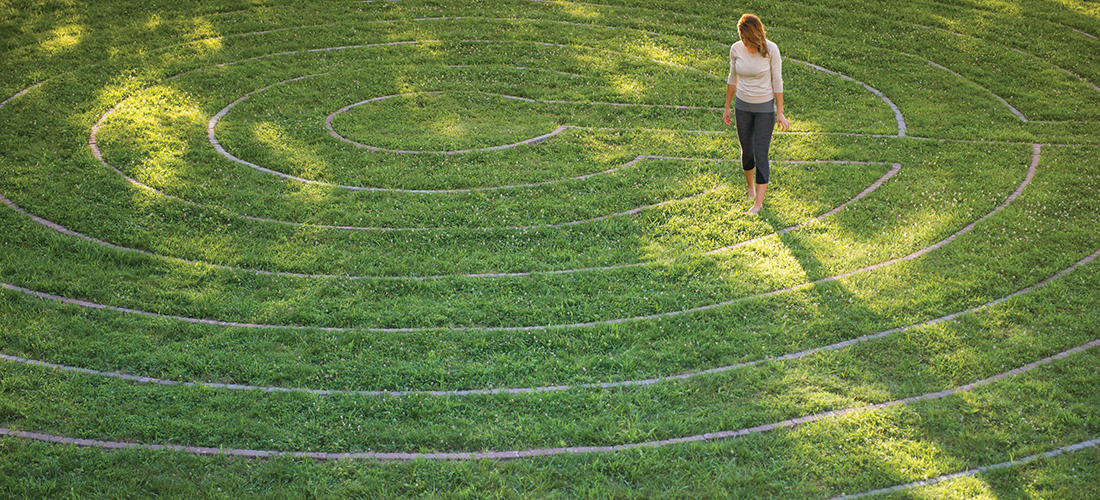Exploring The Art of Living and its updated Ayurvedic spa in Boone, NC
Early in the morning, Day 2: On my way up to breakfast, a sign summons me off the main path: Nature Trail. Less than a minute in, I hear a rustle in the dead leaves. I turn to my left. A docile doe is no more than 10 feet away. She’s deeply camouflaged by the brown colors of fall in the mountains. She’s stunning, and still as a statue. Neither of us moves. I desperately want to be friends with her, but she is suspicious, timid.
It’s early November in Boone, and the crisp air is a relief from the heat back home in Charlotte, where summer has long overstayed its welcome. At this elevation, most of the leaves have fallen. The sky is North Carolina’s signature blue.

The Art of Living Retreat Center is an expansive complex that towers high over Boone, about two-and-a-half hours northwest of Charlotte. Founded by spiritual teacher Sri Sri Ravi Shankar, the center offers wellness retreats, courses and programs taught by its own staff and also hosts spiritual leaders from around the world. Whatever you’re in search of — yoga, ayurveda spa treatments, nature walks, silence, holistic wellness — whatever language you want to use, you’ll likely find an opportunity to explore it at the Art of Living.
During my short visit, I spend most of my time in two key areas: the dining room and the spa, though the retreat covers 380 acres and consists of many buildings, residences, a meditative labyrinth, a clay-making center and stunning views.
After I check in, I drive down a steep, winding road to the new shankara ayurveda spa for meditation class. Ayurveda is an ancient medical system that emphasizes disease prevention through lifestyle practices. This new yoga studio just opened in November as part of an expansion that included 20 hotel suites, an exercise pool and float tank, and a demo kitchen where guests can learn ayurvedic cooking techniques.
I’m late, so it’s not exactly the best start. About 25 guests line the walls, though few are in the center of the room, where I unfold my mat. Fortunately, class hasn’t started. Kunwar Gadhok (who doubles as the retreat’s marketing director) sits at the front of the room, knees crossed, and asks us each to announce why we are here and what we hope to get out of the class — and our favorite ice cream flavor. One young woman from New York is here to learn more about meditation. Rocky Road. A woman from Toronto, to center herself. Pistachio. Another, to slow down and reclaim her life. Vanilla. I’m here, as a journalist, to learn more about the center and meditation. I am here in search of peace. Coffee, hands down.

In his soothing baritone, Gadhok tells us that he began meditating with his dad when he was 9 years old, before he even knew what it was. He loved the inner peace he felt after meditations, and in 2018, after a stint in corporate America, he devoted his life to sharing it with others.
He guides us through intentional breath, at first a test of patience. A pesky crow whines outside our window, distracting me, but overall I feel lighter and calm when we’re done.

At lunch, I meet Kim Rossi, the spa director, and Lokesh. Lokesh is a small, rotund man with a smile permanently planted on his face. He wears a flowing, white linen suit. Immediately, I like him. His smile makes me smile.
Known formally as Dr. Lokesh Raturi, he is an expert in nadi pariksha, or pulse diagnosis. Born in the Western Himalayas into a family tradition of herbal healing, Lokesh directed his own clinic before turning to education, training ayurvedic doctors in the science of pulse diagnosis. I’m skeptical, but intrigued to learn that ayurvedic doctors, or vaidyas, are known for their ability to test the body’s imbalances through a noninvasive checking of the pulse.
First, we need to identify my dosha. In ayurvedic practice, these biological energies govern us internally and provide us with a kind of best-life blueprint. The doshas — Vata, Pitta and Kapha — comprise the five elements. Since I’m “athletic, long and thin, and tend to burn out easily” (from overdoing it), among other descriptors, I’m a Pitta.
Pitta-positive, I sit at the table, left arm up, Lokesh also at my left side.
“Close your eyes,” he says. As my eyelids shut out my insecurity, he presses two fingers (maybe three?) firmly onto my wrist. Within seconds, he tells me that I’m overall healthy, but I have an imbalance at the backs of my legs. I’m sitting in a dining hall in yoga pants with a stranger who can’t see my legs. But he’s right. Much of my life, I’ve been a runner, but this year, a pull in the back side of my right leg has precluded me from running much at all.
Rossi has days’ worth of advice to share, dozens of dos and don’ts for the Pitta. I’m most in balance from summer into early fall, and I should drink chai tea instead of coffee — it’s less acidic. Later, she develops a customized diet for me to consider. (The Art of Living is one of a handful of centers in the U.S. where guests can come to experience Panchakarma detox retreats that consist of next-level fasting and cleansing.)
Make no mistake — the Art of Living is more of a spiritual retreat than your typical resort spa. That night, my room is a comforting contrast to the brisk Blue Ridge air. Rustic, with simple amenities, there are no airs of luxury, just a gentle nudge to return to what matters most.
When I wake the next morning, the sunlight hugs the trees and makes me smile. In the distance, fall’s final leaves hang on. I’m grateful.
Near the spa, in the new kitchen, Swapna Venkat hosts a cooking class and shows us how to make kichadi, a traditional Indian rice dish touted for its cleansing, anti-inflammatory powers. Her smile is more permanent, and, if possible, more genuine than Lokesh’s. My knee-jerk reaction is to hug her.
Venkat recently moved to the U.S. from India. With the class huddled around her stove, she shares recipes in a hushed tone, like she’s telling a secret. “My mother shared [these recipes] with me, and I am so happy to share with you,” she says. She’s full of health tips, too. Cinnamon is good for circulation. Fennel aids in digestion. She’s giddy about ghee, or clarified butter, a staple in the ayurvedic practice. A framed poster hangs on the wall, a color-coded reminder of what to increase and reduce in your diet based on each of the three doshas.
Later, at the spa, I wait in a modern, sunsoaked room. A short, no-nonsense woman with dark features and a demeanor that implies, “I’ll get you straightened right up,” calls out my name.
Alice moved from Boston to Boone for this job. She explains that Abhyanga, the type of massage I’m signed up for, is a form of ayurvedic treatment that involves massaging the body with warm, herb-infused oils. I lie on the table, and she drizzles my back with heated sesame oil. (“Good for digestion and blood flow and balancing the doshas,” Alice says.)
With fast, firm sweeps, she moves her hands up and down my arms and legs, with quick motions on my abdomen. The whole experience lasts an hour and leaves me feeling, in a word, warm. I rise to the peace of the mountains in the distance, and walk to the steam room, which should help the oil penetrate my skin and help me cleanse.
Concentrated wellness is all well and good, but as the weekend winds down, I’m ready to go home to reconnect with my new husband and my cat.
I can’t say what I expected out of the trip — insight, rest, tension relief. But more resonating, while straying along a mountain path one cold morning, I encountered a new friend, and, for a moment, found peace.


